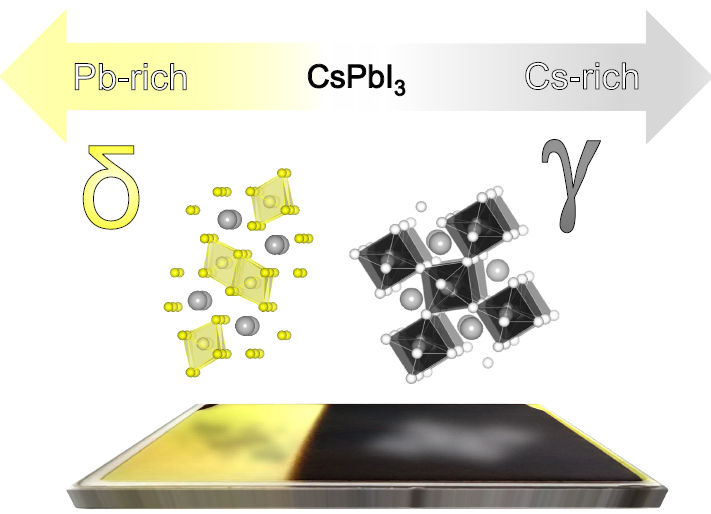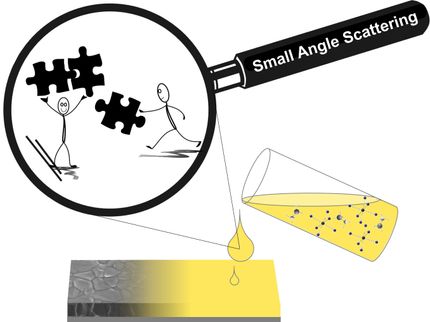Inorganic perovskite absorbers for use in thin-film solar cells
A team at the Helmholtz-Zentrum Berlin has succeeded in producing inorganic perovskite thin films at moderate temperatures using co-evaporation – making post-tempering at high temperatures unnecessary. The process makes it much easier to produce thin-film solar cells from this material. In comparison to metal-organic hybrid perovskites, inorganic perovskites are more thermally stable.

By co-evaporation of cesium iodide and lead iodide thin layers of CsPbI3 can be produced even at moderate temperatures. An excess of cesium leads to stable perovskite phases.
Copyright: J. Marquez-Prieto/HZB
Teams all over the world are working intensively on the development of perovskite solar cells. The focus is on what are known as metal-organic hybrid perovskites whose crystal structure is composed of inorganic elements such as lead and iodine as well as an organic molecule.
Completely inorganic perovskite semiconductors such as CsPbI3 have the same crystalline structure as hybrid perovskites, but contain an alkali metal such as caesium instead of an organic molecule. This makes them much more stable than hybrid perovskites, but usually requires an extra production step at very high temperature – several hundred degrees Celsius. For this reason, inorganic perovskite semiconductors have thus far been difficult to integrate into thin-film solar cells that cannot withstand high temperatures. A team headed by Dr. Thomas Unold has now succeeded in producing inorganic perovskite semiconductors at moderate temperatures so that they might also be used in thin-film cells in the future.
The physicists designed an innovative experiment in which they synthesised and analysed many combinations of material within a single sample. Using co-evaporation of caesium-iodide and lead-iodide, they produced thin layers of CsPbI3, systematically varying the amounts of these elements, while the substrate-temperature was less than 60 degrees Celsius.
“A combinatorial research approach like this allows us to find optimal production parameters for new material systems much faster than with the conventional approach that typically requires 100 samples to be produced for 100 different compositions”, explains Unold. Through careful analysis during synthesis and the subsequent measurements of the optoelectronic properties, they were able to determine how the composition of the thin film affects the material properties.
Their measurements show that the structural as well as important optoelectronic properties of the material are sensitive to the ratio of caesium to lead. Thus, excess caesium promotes a stable perovskite phase with good mobility and lifetimes of the charge carriers.
In cooperation with the HZB Young Investigator Group of Prof. Steve Albrecht, these optimized CsPbI3 layers were used to demonstrate perovskite solar cells with an initial efficiency of more than 12 % and stable performance close to 11% for over 1200 hours. “We have shown that inorganic perovskite absorbers might also be suitable for use in thin-film solar cells if they can be manufactured adequately. We believe that there is great room for further improvements”, says Unold.
Original publication
Pascal Becker, José A. Márquez, Justus Just, Amran Al-Ashouri, Charles Hages, Hannes Hempel, Marko Jošt, Steve Albrecht, Ronald Frahm and Thomas Unold; "Low temperature synthesis of stable CsPbI3 perovskite layers for solar cells obtained by high throughput experimentation"; Advanced Energy Materials; 2019
Original publication
Pascal Becker, José A. Márquez, Justus Just, Amran Al-Ashouri, Charles Hages, Hannes Hempel, Marko Jošt, Steve Albrecht, Ronald Frahm and Thomas Unold; "Low temperature synthesis of stable CsPbI3 perovskite layers for solar cells obtained by high throughput experimentation"; Advanced Energy Materials; 2019
Organizations
Other news from the department science

Get the chemical industry in your inbox
By submitting this form you agree that LUMITOS AG will send you the newsletter(s) selected above by email. Your data will not be passed on to third parties. Your data will be stored and processed in accordance with our data protection regulations. LUMITOS may contact you by email for the purpose of advertising or market and opinion surveys. You can revoke your consent at any time without giving reasons to LUMITOS AG, Ernst-Augustin-Str. 2, 12489 Berlin, Germany or by e-mail at revoke@lumitos.com with effect for the future. In addition, each email contains a link to unsubscribe from the corresponding newsletter.
Most read news
More news from our other portals
Last viewed contents

Sika Argentina S.A.I.C. - Buenos Aires / Caseros, Argentina

PENTAC Polymer GmbH - Gross-Umstadt, Germany

Brenntag N.V. - Deerlijk, Belgium

Rötzmeier Sicherheitsbehälter OHG - Salzkotten, Germany

varolab GmbH - Giesen, Germany

Chemtrac, Inc. - Norcross, USA




























































